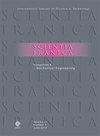一种有效的分散液液微萃取方法:中心复合设计优化
IF 1.9
4区 工程技术
Q2 ENGINEERING, MULTIDISCIPLINARY
引用次数: 0
摘要
在这项研究中,开发了一种简单有效的分散液-液微萃取法(DLLME),用于从水样中去除双氯芬酸钠(DF)。考察双氯芬酸水相浓度(10 ~ 50 mg/L)、萃取时间(2 ~ 10 min)、萃取溶剂浓度(0.005 ~ 0.025 M)、离心转速(1000 ~ 5000 rpm)等参数。27实验设计采用响应面法(RSM) 28根据中心组合设计,以减少实验次数,确定29个最佳提取条件。评价了单操作参数和同时操作参数30的影响。实验结果表明,提取浓度为0.01 M,双氯芬酸31水相初始浓度为20 mg/L,离心机转速为4000 rpm,停留时间为8 min,为最佳操作条件。根据其他33项研究和现有发现,两相有机和水排放的比例(Q / Q aq)被设置为1:9。在35个最佳操作条件下,双氯芬酸的水相提取率为77.91%。36本文章由计算机程序翻译,如有差异,请以英文原文为准。
An effective dispersive liquid-liquid microextraction method for pharmaceutical extraction: Optimization via central composite design
23 In this study, a simple and efficient dispersive liquid-liquid microextraction procedure (DLLME) 24 was developed to remove diclofenac sodium (DF) from water samples. Various parameters such 25 as diclofenac concentration in aqueous phase (10-50 mg/L), process time (2-10 min), extraction 26 solvent concentration (0.005-0.025 M), and centrifuge speed (1000-5000 rpm) were investigated. 27 The experimental design was performed by the Response Surface Methodology (RSM) 28 according to the central composite design to reduce the number of experiments and determine the 29 optimal extraction conditions. The effect of the single and simultaneous operational parameters 30 was evaluated. In this regard, the extraction concentration of 0.01 M, the initial diclofenac 31 concentration in aqueous phase 20 mg/L, the rotation speed of the centrifuge 4000 rpm, and the 32 residence time of 8 min were obtained as the optimum operating conditions. According to the 33 other studies and available findings, the ratio of two-phase organic and aqueous discharges 34 (Q org ⁄Q aq ) was set to 1:9. The diclofenac extraction from the aqueous phase was 77.91% in 35 optimum operating conditions. 36
求助全文
通过发布文献求助,成功后即可免费获取论文全文。
去求助
来源期刊

Scientia Iranica
工程技术-工程:综合
CiteScore
2.90
自引率
7.10%
发文量
59
审稿时长
2 months
期刊介绍:
The objectives of Scientia Iranica are two-fold. The first is to provide a forum for the presentation of original works by scientists and engineers from around the world. The second is to open an effective channel to enhance the level of communication between scientists and engineers and the exchange of state-of-the-art research and ideas.
The scope of the journal is broad and multidisciplinary in technical sciences and engineering. It encompasses theoretical and experimental research. Specific areas include but not limited to chemistry, chemical engineering, civil engineering, control and computer engineering, electrical engineering, material, manufacturing and industrial management, mathematics, mechanical engineering, nuclear engineering, petroleum engineering, physics, nanotechnology.
 求助内容:
求助内容: 应助结果提醒方式:
应助结果提醒方式:


